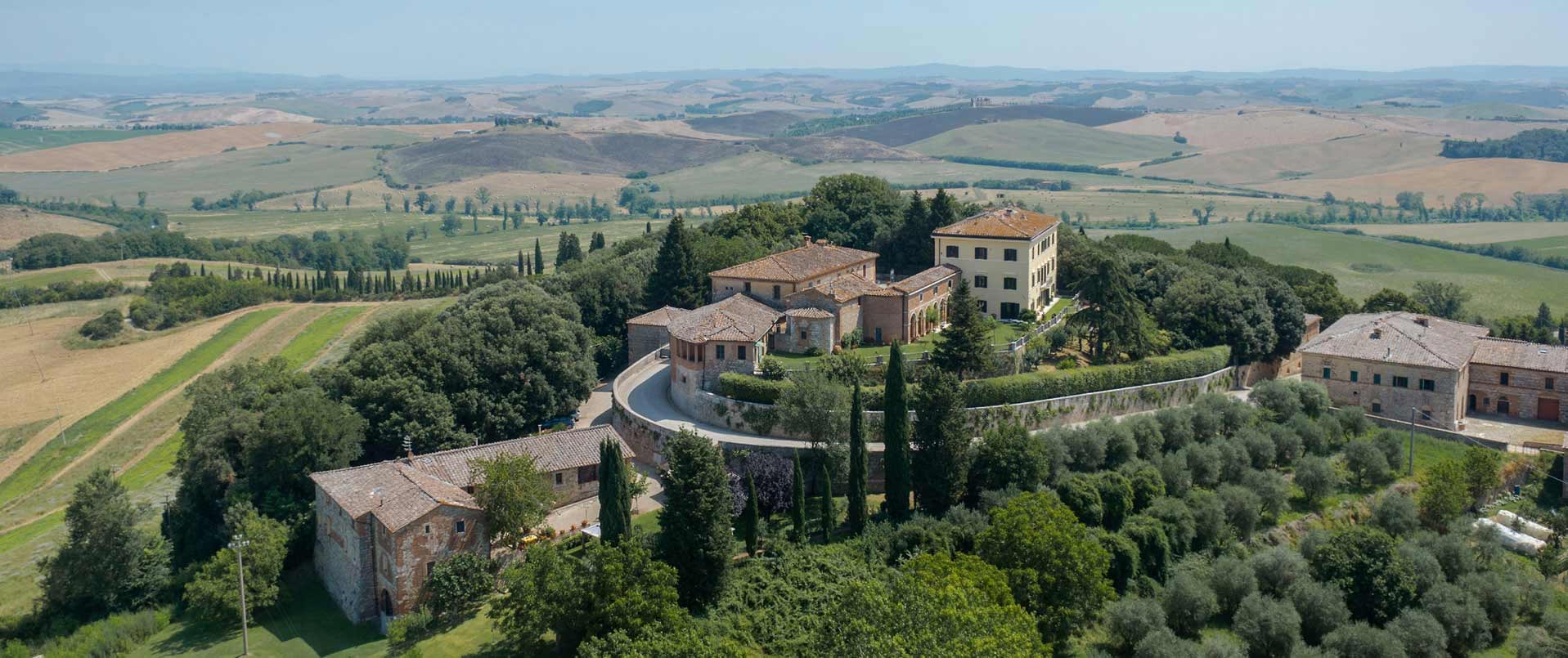
The resort of Palazzo di Varignana graces the picturesque hills of the village from which it derives its name and is nestled in the breath-taking beauty of the luxuriant landscape all around, just a short distance from Bologna and close to Castel San Pietro Terme. At its heart stands Palazzo Bentivoglio, an ancient villa dating back to 1705 and carefully restored to preserve all the charm of its long history, around which spans a complex of over 30 hectares of land comprising extensive green spaces, parks and water sources, all offering magnificent views. The various different structures are connected by underground passageways and stylish internal corridors, which together form a village resort divided into five elegant residential complexes containing 134 rooms. A linear, contemporary style has been chosen to decorate them, their inviting colours and materials blending seamlessly with the natural landscape of the surrounding hills.
The 134 spacious rooms at Palazzo di Varignana are intimate and welcoming, their almost homely atmosphere enhanced by the aesthetically pleasing furnishings and objects they feature. The highly effective mix of innovative design and state-of-the-art technology is coupled with an array of creative ideas, which are all geared towards providing maximum comfort. The rooms range from 23 to 76 square metres in size and all share a common characteristic, namely their natural brightness. Combined with the elegance of the colours and materials selected and the endless natural spectacle in which they are positioned, each room is guaranteed to offer the highest level of comfort and hospitality.
In addition to the rooms at the resort, there are 5 additional Villas nestled in the lush peace and tranquillity of the Bolognese hills. These are superb residences that are the ideal setting for holidays with family or friends, where the privacy of a private property has all the conveniences provided when staying at a luxury resort.
The history of Palazzo di Varignana
The history of Varignana dates back to the 2nd century B.C. with the foundation of the city of Claterna by the Romans. This town prospered economically in Roman times, primarily thanks to Consul Marcus Aemilius Lepidus who introduced the passing of the famous road bearing his name, Via Emilia, through its centre in 189 B.C.
Unlike many of the cities founded in Roman times, Claterna unfortunately did not survive the collapse of the Western Roman Empire. With the onset of the Middle Ages, the city’s defensive needs changed radically, and it was gradually abandoned. The inhabitants relocated to a village protected by hills and wide walls where, after a long period of transition, the Castle of Varignana was founded around the 10th century A.D. Throughout the medieval period, the village continued to expand and change structurally, including the construction of the Church of San Lorenzo at the northern entrance to the village. There were also political changes, with the admission of Varignana to the municipality of Castel San Pietro.
The Castle continued to maintain its role as a fortified village, and the tower-house, the seat of the administrative authority, still bears witness to its ancient splendour today.
Varignana came back into the forefront of political events during the French occupation, more precisely with the appointment in 1794 of Count Antonio Bentivoglio, who resided in the majestic Palazzo Bargellini-Bentivoglio. This had been built almost a century earlier (1705) by Count Orazio Bargellini and was believed to have been designed by Francesco Angiolini, who was considered the greatest architect in Bologna during the 18th century.
FACILITIES AND SERVICES: ACCOMMODATION, WEDDINGS AND PRIVATE EVENTS NEAR BOLOGNA
Palazzo di Varignana is located in a magical setting, where its guests can completely relax and enjoy all the many amenities offered at the resort to the full.
The conference centre
The Bentivoglio Conference Centre provides a 300-square-metre plenary hall meeting area with natural light and modular walls that can be adapted for any type of event, thanks also to the installation of advanced technology systems. The spaces are all equipped to meet every kind of requirement, from screening full HD videos to Wi-Fi and video conference facilities. There is an adjacent 200-square-metre foyer, ideal for welcoming delegates and proposing coffee breaks. In addition, 880 square metres are available for use in the adjoining Belvedere Space, a large multi-functional area that can be divided into 7 further meeting rooms. January 2021 also saw the opening of the ‘Studios’: a professional television set where it is possible to host hybrid events, meetings, conferences and advertising shoots, as well as streaming and broadcasting sessions.
AUREVO POOL RESTAURANT
Immersed in the greenery of Palazzo di Varignana’s grounds, with bright glass walls overlooking the swimming pool and the water features of the solarium, AUREVO Pool Restaurant is an idyllic place to enjoy light, flavoursome dishes. Thanks to its panoramic terrace, guests can enjoy an equally special lunch or dinner during the summer months, when they can fully appreciate the spectacular panorama of the surrounding hills. Poolside themed events are often held here in the evenings, including private gatherings.
‘Le Marzoline’ Trattoria
For lovers of the wonderful culinary tradition to be enjoyed in the Emilia-Romagna region, Palazzo di Varignana proposes the ‘Le Marzoline’ restaurant, a homage to the typical trattorias of the area set in the midst of the green hills of Varignana. This ancient two-storey farmhouse has been completely renovated and designed to accommodate a total of 90 people indoors and, during the summer months, an additional 100 guests in the charming outdoor seating area.
Lounge Bar
Featuring fabulous outdoor terraces overlooking the scenic surroundings of the resort, the Lounge Bar is the very epitome of design, style and creativity. The perfect place to savour a delicious, leisurely aperitif or linger over ‘happy hour’ in pleasant company, tasting a wide variety of cocktails, the bar lends itself beautifully to social occasions with friends after work, for after dinner drinks or for relaxing during the weekend. Its cosy, intimate atmosphere also makes it a charming location for private events and business meetings.
Varsana health & wellness SPA
The Spa‘s new concept emphasizes its commitment to health and well-being and its close connection with the territory. These two central concepts can transform a holiday into a journey of self-discovery, aimed at finding new lifestyles suitable for those seeking improved psycho-physical balance. The exclusive products at Palazzo di Varignana – which are already used in dishes served at the resort and in their extensive production of oil, wine, jams, and juices – are the leading protagonists of treatments featured in the spa and Palazzo di Varignana’s high-quality cosmetic line.
In the Spa, the space formerly known as Spa Fusion has evolved into ARS VIVENDI, embodying the ART of LIVING WELL. It is in the pursuit of the art of living well, a common denominator in cultures worldwide and ancient traditions, passing from Japan to Morocco and through the ancient thermal culture of ancient Rome, that rituals for the body and mind can be explored, promoting a sense of harmony and well-being.
The Medical Center
The new Medical Centre at Palazzo di Varignana is now open, with the launch of a programme of activities and treatments promoting immune response and metabolic activity under the guidance of Dr. Annamaria Acquaviva. The ‘Studio Medico’, meanwhile, draws on the expertise of Dr. Maria Immacolata de Vicariis, a surgeon practising Oxygen-Ozone Therapy aimed at improving the defence systems against the action of free radicals and tissue oxidation. Another innovative offering is ‘IV Therapy’: intravenous infusions of 3 different blends of vitamins, nutrients and antioxidants named Detox, Energy, and Immuno Defense.
Recreational and sporting activities
Digital app with walking and cycling routes on the estate and around the resort
Gym: open 24/7
Tennis court, basketball half court, paddle tennis courts and squash courts
Golf: putting green and driving range with 11 stations for long range shots
Outdoor swimming pools (open from May to September)
Outdoor wellness area with a fitness trail
Outdoor children’s play area
The ornamental garden
In 2015, Palazzo di Varignana expanded its estate, enriching the charm of its grounds by acquiring one of the gardens included in the prestigious Italian Great Gardens of the World network.
Range of agro-food products
Palazzo di Varignana now extends over more than 300 hectares of agricultural land, covering a vast area of the hillside south of the Via Emilia road in the village of Varignana in Castel San Pietro Terme. Among these, 150 hectares of olive groves produce precious Extra Virgin Olive Oil, considered a product of absolute excellence across the entire Italian territory. In addition to the olive groves, there are 42 hectares of vineyards, where indigenous grapes are predominantly cultivated, 3,000 metres of vegetable garden, one hectare of almond trees, a strawberry field, an orchard with apples, pears, apricots and cherries, 4,000 metres cultivated with goji berries, a terraced herb garden with 42 different aromatic herbs and a very unique and rare production of saffron.
Places of interest in the nearby
Dozza: Art plays a significant role in the cultural life of the fascinating medieval village of Dozza. The Biennial Exhibition of the Painted Wall or ‘Biennale del Muro Dipinto’ is held here, an event where artists from different backgrounds gather in its streets to paint the walls of buildings, creating a wonderful open-air art gallery. Another ‘must-visit’ in Dozza is the imposing Rocca Sforza fortress, which houses an art gallery and a regional wine shop where you can taste and purchase the most renowned wines of Emilia-Romagna.
The Lamborghini Museum: The greatest Lamborghini creations, featuring hundreds of historical photos and captions, accompany visitors around this museum, explaining the daring dreams of Ferruccio Lamborghini and creating a magical atmosphere that recalls the exciting and courageous days of the post-war period. With its backdrop of the magnificent structure of the Ferruccio Lamborghini Multi-purpose Centre, even the smallest architectural details are inspired by the typical style of the famous Italian car manufacturer.
Bologna: Every corner of this great city recounts the history of our country. The medieval historic centre, one of the best-preserved in Europe, is characterised by its 40 kilometres of arcades and the red brick buildings that give the city its warm and unmistakable atmosphere. The ‘Two Towers’, a true symbol of the city, are the last remaining vestiges of the nearly two hundred tower-houses that once dominated it during the Middle Ages. In addition to the history hidden among the Palazzos, piazzas, prestigious museums, churches and beautiful gardens, the city pulsates with life both day and night with its numerous taverns, theatres, open-air markets and shops offering typical products, heirs of the culinary tradition that has made it so famous.
Ferrara: A small city that has been declared a UNESCO World Heritage Site, Ferrara was famous for being the capital of the Estense Duchy until 1598, the year of its Devolution or annexation into the Papal States. Today, it has retained all the tranquillity of an Italian provincial town while preserving the many traces of its ancient splendour. The Estense Castle dominates the city with its four large corner towers, square in shape and capped with battlements, while around the splendid Cathedral, we still find the streets of the medieval area, with its alleys, small Gothic churches, the old Jewish Ghetto and many Synagogues.
Ravenna: Ravenna represents an intricate historical tapestry, which spans from Roman emperors to the reign of the Popes, to the city being awarded the ‘Medaglia d’Oro al Valore Militare’ (Gold Medal of Military Valour, one of Italy’s highest military awards, given to individuals and military units for their extraordinary courage and valour during World War II). It has a wealth of monuments and churches and provided the final resting place for Dante Alighieri and Anita Garibaldi. Whether visiting the Basilica of San Francesco, the Mausoleum of Theodoric or Dante’s tomb, every inch of the city visitors can relive a period of Italian history at every corner.
Rimini: Rimini is not only a seaside resort on the Romagnola Riviera, but it is also a city of considerable historical and cultural significance. A colony founded by the Romans in 268 B.C., it features numerous Roman monuments such as the Arch of Augustus, the Tiberius Bridge and the Amphitheatre. During the early Renaissance, under the Malatesta family, its court was one of the liveliest of the era, hosting artists like Leon Battista Alberti, Piero della Francesca, Roberto Valturio and Matteo de’ Pasti, who produced works such as the Malatesta Temple, which can still be admired in the historic centre.
San Marino: Europe’s oldest republic doesn’t rely solely on its history. Events, festivals, sporting competitions, music and theatre are some of the myriad proposals providing visitors with new experiences in one of the most charming tourist destinations in the world. From shopping to cultural events, including the reenactment of significant historical events, there is always a host of reasons for visiting San Marino. At the foot of Mount Titano, you will find the ‘Maranello Rosso’ museums entirely dedicated to the history, life, and cars of Enzo Ferrari and Carlo Abarth, where visitors can immerse themselves in the unique atmosphere of these brands and become protagonists of an exciting journey through the history of the world’s most famous automobiles.
Florence: Founded by the Romans in the first century B.C., Florence is a hugely important city renowned for its manufacturing and commerce, culture, art and science. It is held up to be the art capital of Italy and the greatest exponent of the Renaissance period, as well as being the mother of the Italian language and home to a number of national geniuses. Nestled in a basin surrounded by hills stretching along the banks of the Arno River, it possesses an exceptional artistic heritage, including works by Cimabue and Giotto (considered the fathers of Italian painting), and masterpieces by Leonardo da Vinci and Michelangelo, Boccaccio and Dante. Visiting the historic centre, you will be captivated by magnificent structures like the Cathedral of Santa Maria del Fiore, the Baptistery, the Uffizi Gallery, the Bargello Museum, the Accademia Gallery, the churches of Santa Maria Novella and Santa Croce, and the famous Palazzo Pitti and Ponte Vecchio. It is impossible not to deem Florence one of the most beautiful cities in the world.
Modena – Visiting a Traditional Balsamic Vinegar Producer: Discover the honest pleasure of ‘agro’ (the tart or tangy flavour characteristic of balsamic vinegar) by visiting a traditional producer and restaurant showcasing the various sometimes unexpected uses of a ‘liquid’ whose production techniques have been passed down from generation to generation, even constituting a historical ‘dowry’ for young maidens. It is only after an appropriate period of ageing that the product achieves the surprising balance of aromas and flavours that permit it to be labelled as a protected designation of origin (PDO). The ageing that takes place in a series of small barrels made of various types of wood, with each barrel progressively smaller in size, imparts a distinctive texture and a unique aroma to the vinegar. During the visit, explanations will be given on what the main rules are that need to be followed in order to obtain the best Traditional Balsamic Vinegar of Modena and, at long last, you will be given the opportunity to taste the products.
Galleria Ferrari: The official exhibition of the House of the Prancing Horse (the ‘Cavallino Rampante’ as it is fondly known) is just a stone’s throw from the world’s most famous factory. The true custodian of the myth, the Museo Ferrari, was founded in Maranello in 1990 under the name of ‘Galleria Ferrari’ and has since housed the cars, images and trophies that have written the history of this world-famous brand. The museum is divided into two large halls, where the most memorable vintage and contemporary cars are displayed together with historical photos, memorabilia and trophies. Sophisticated mechanical and electronic components are also on display.
 Accommodation
Accommodation
 Co-Working
Co-Working
 Film sets
Film sets
 Gardens
Gardens
 Parks
Parks
 Pet Friendly
Pet Friendly
 Private events
Private events
 Residences
Residences
 Visits
Visits
 Weddings
Weddings
 Cultural tourism
Cultural tourism  Cyclotourism
Cyclotourism  Excursions
Excursions  Gardens
Gardens  Hiking
Hiking  Historic Homes open to visitors
Historic Homes open to visitors  Nature
Nature  Restaurants
Restaurants  Sports
Sports  Tasting
Tasting  Walking itineraries
Walking itineraries  Wine tourism
Wine tourism